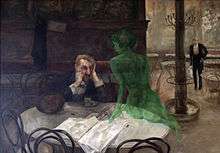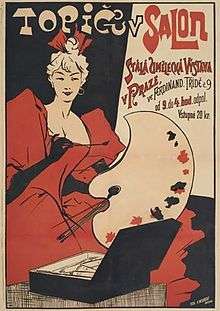Viktor Oliva



Viktor Oliva (April 24, 1861 – April 5, 1928) was a Czech painter and illustrator.
His most famous painting, "Absinthe Drinker" (Czech: Piják absintu), hangs on the wall of the historical Café Slavia in Prague, Czech Republic.
Life and work
Viktor Oliva was a master of drawing, illustration, and painting born in Nové Strašecí, Bohemia, Austria-Hungary 24 April 1861. His main style was Art Nouveau. At the age of 17 he attended the Academy of Fine Arts, Prague and studied under František Sequens, who respected his work greatly. He continued his studies at the Munich Academy.[1]
In 1888 he was drawn to the Montmartre area of Paris to be part of the ever rapidly expanding artistic community there. He lived there for some years and became good friends with other "Bohemian Parisiens" such as Luděk Marold, Mikoláš Aleš, Jakub Arbes, and Karel Vítězslav Mašek. This group of actual Bohemians (from Bohemia) were right in the heart of the "Bohemian Revolution".[1]
His art greatly improved in such a richly artistic environment. Paris is where he discovered the joy of Absinthe. He also greatly loved the exhilaration of ballooning. This group all held very true to the ideals that the Artistic Bohemians believed in. They all lived and worked there for several years before returning to their home in true Bohemia.[1]
In 1897 he was given the job of Images Editor at the very popular Czech language magazine Zlatá Praha (Golden Prague). He held this job for 19 years. Shortly after he started work there, he married a lovely girl named Anna Adamcová who was enamored with his talent. Not long after that, she gave birth to his son Viktor Oliva Jr. (also was an aspiring artist). The marriage didn't last long, as Anna ran away with a singer named Mařák. Oliva was still able to spend some time with his son, which brought him very much joy.[1]
Over the next quarter century, Oliva was very prolific in his work. He spent a lot of time with his extremely worldly best friend Josef Kořenský (a true world traveler at a time when this was incredibly difficult). Oliva was commissioned to create many dramatic works including the ceilings of several buildings in Bohemia. He also had several works hanging in his favorite cafe, Café Slavia (which now still has his most famous work "Piják absintu" (Absinthe Drinker) hanging proudly inside).[1]
He was profiled in Český Svět magazine (a Czech lifestyle magazine like People and Time) in 1926, two years before his death. Here is a translation of the text:
"Anniversary of the life (65th birthday) of such a kind and likable artist sets our memories well back – to the end of the 1880s – when the very young artist Oliva began to help with artistic decoration of Czech books with such an elegance and charm, that he soon became one of the most famous Czech illustrators up there with Luděk Marold, for example.
He's done illustrations for several books of Svatopluk Čech, Jan Neruda, Karel Václav Rais, Václav Beneš Třebízský, Kronbauer – those were published for almost two decades with Viktor Oliva's illustrations. As well as numerous of other books as one of the first Czech artists in that area. Much of his work, his credits, are still underrated and sometimes even forgotten.
We know Mr. Oliva as well as a landscape drawer and figure artist, of very high quality and duality – huge canvases of his hang in Café Slavia, the walls of buildings on beautiful Slavia Island, and Mestanska Beseda in Pilsen. They are still able to capture you with strong emotions and beautiful performance.
He died on 5 April 1928 in Prague. He was buried in Olšany Cemetery in an area for famous artists.[1]
Opinions from the art world of the early 21st century
According to an annotation from what is most likely the Troja Chateau gallery in Prague:
- "The youngest artist at Troja is Viktor Oliva. He was primarily a graphic artist. His dust covers, book bindings and posters are among the best examples of Czech applied graphic art of the 1890s. In addition, however, he painted several ceilings and decorations for a number of Prague cafes. The entire work bespeaks the influence of French fin de siecle art, which is also a characteristic of Oliva's portraits."[2]
According to the catalog of Czech art auction house Meissner-Neumann:
- "Czech painter and illustrator, he studied under F. Sequens at the Academy of Art in Prague, then in Munich and Paris. He was influenced by the work of his friend L. Marold. He created chiefly portraits and large-scale paintings following the historicizing stream in art. His portraits and large number of illustrations for books by Czech and European authors as well as his poster designs testify to the contemporary life style based on the Art Nouveau style."[3]
Timeline of major events in his life
- 1861 Born Nové Strašecí
- 1878 Prague's Academy of Art
- 1880s? Munich Academy
- 1888 Lived in Paris
- 1891 August 27, Balloonist crew with Louise Godard described in book "From Prague to the Baltic Sea by balloon" by J.R.Vilimek
- 1897-1916 Zlata Praha (Otto's publishing company)
- Married Anna Andomcová
- 1898 Son Viktor Oliva Jr.
- Wife left him for singer Mařák
- 1926 Profiled in Cesky Svet
- 1928 Died Prague
- Buried in Olšany Cemetery in area for famous artists.
Notable friends
- Mikoláš Aleš, artist.
- Jakub Arbes. artist.
- Josef Kořenský, world traveler for whom Oliva illustrated books.
- Luděk Marold, artist.
- Karel Vítězslav Mašek, artist.
References
| Wikimedia Commons has media related to Viktor Oliva. |
- 1 2 3 4 5 6 Oliva Absinthe. "[History of Viktor Oliva Buy Absinthe]". Retrieved 2007-03-05.
- ↑ Troja Chateau Gallery?. "[Untitled list of European painters]". Archived from the original on March 1, 2005. Retrieved 2006-06-10.
- ↑ Meissner - Neumann (March 2004). "10. PAINTINGS". Catalogue / ORDER OF SALE (3/2004). Retrieved 2006-06-10.